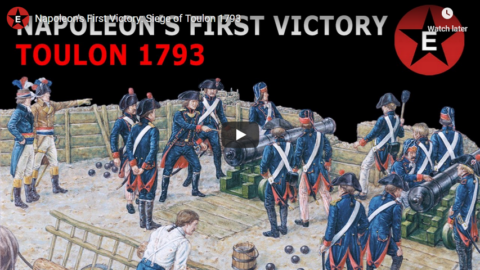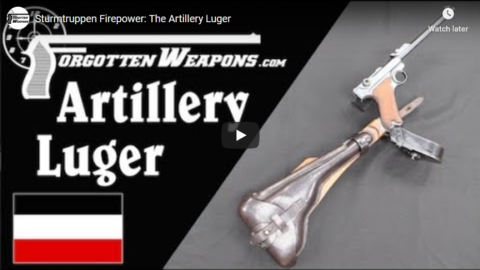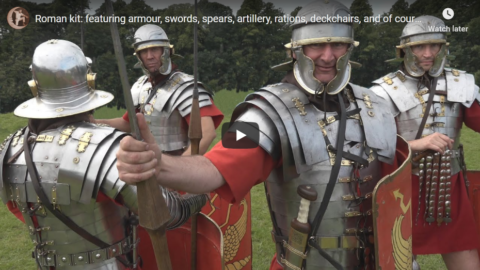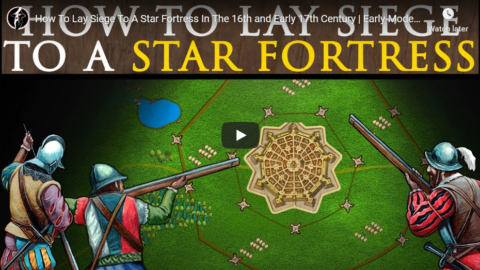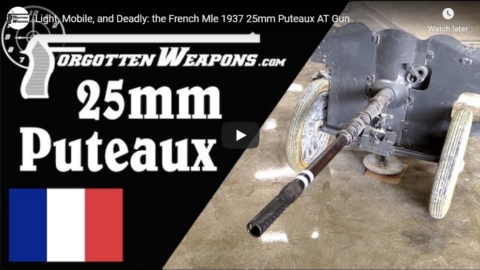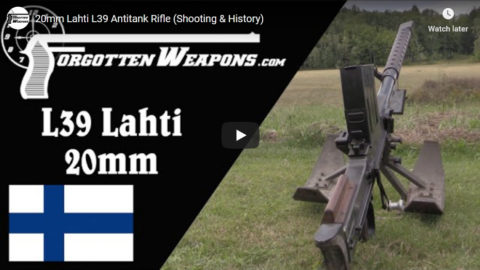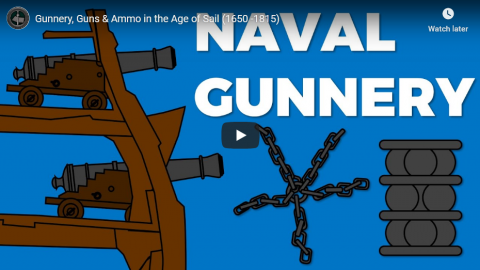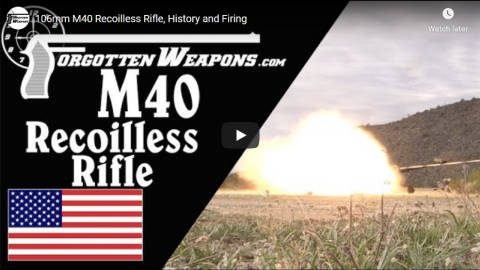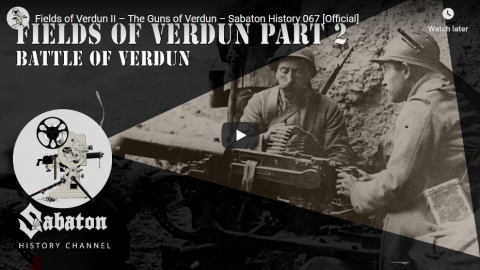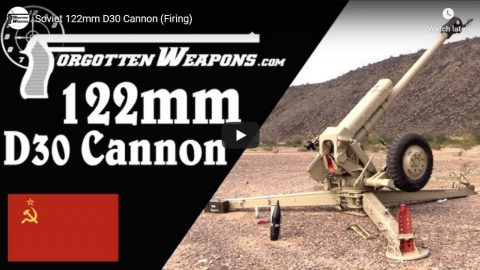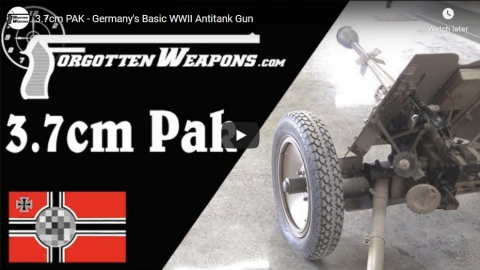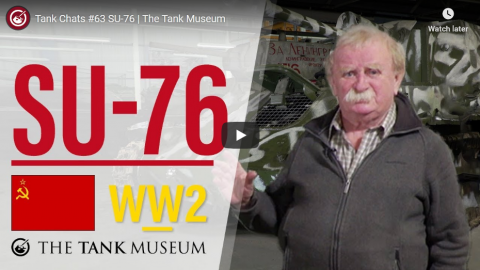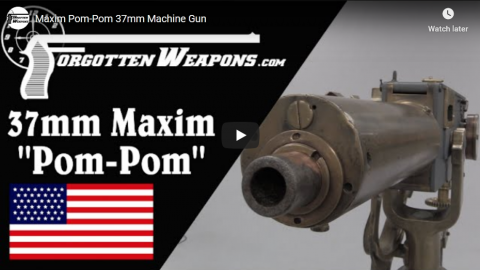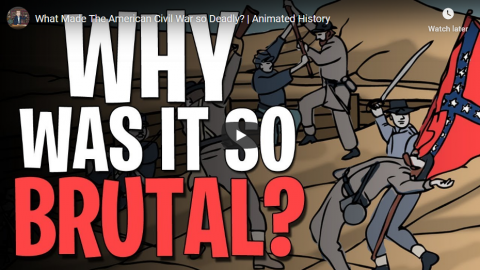Epic History TV
Published 31 Mar 2018Get Epic History TV early access & voting rights at Patreon: https://www.patreon.com/epichistorytv
With big thanks to HistoryMarche, check out his channel here: https://www.youtube.com/channel/UC8MX…
Find Osprey books on the Napoleonic Wars here:
https://ospreypublishing.com/#EpicHistoryTV #NapoleonicWars #Napoleon
Music from Filmstro https://www.filmstro.com/
Get 20% off an annual license with this exclusive code:EPICHISTORYTV_ANNFrom Osprey Publishing (as an Amazon Associate I earn from qualifying purchases):
Toulon 1793: Napoleon’s first great victory: http://geni.us/vUITM
French Revolutionary Infantry 1789-1802: http://geni.us/RsWkNN
Napoleon’s Guns 1792-1815 (1): Field Artillery: http://geni.us/YWU1HaZ
Napoleon’s Guns 1792-1815 (2): Heavy and Siege Artillery: http://geni.us/SJn9I
August 18, 2020
Napoleon’s First Victory: Siege of Toulon 1793
August 4, 2020
Sturmtruppen Firepower: The Artillery Luger
Forgotten Weapons
Published 4 Apr 2020https://www.instagram.com/rockislanda…
https://www.youtube.com/user/RockIsla…
This is lot #3569 in the upcoming RIA Premier Auction. It was scheduled for April, but has been postponed — check their web site for upcoming Online Only auctions every month, though!
The lP08 (Lange pistole 08) was formally adopted in 1913 to replace the Reichsrevolver for the field artillery. These were the German light artillery troops, who were specifically given a pistol caliber carbine to provide maximum firepower in a very compact package. They were made by the Erfurt Arsenal in 1914, and by DWM throughout the war, with a total of about 180,000 made.
What is most interesting to me is the evolution of the use of the “artillery Luger” throughout the course of World War One. Starting as simply a compact weapon for artillery, it was quickly recognized by aviators as an ideal weapon for aircraft before the mass introduction of aerial machine guns. The stock allowed more accurate fire, and the semiautomatic operation minimized the handling movements required to fire. More substantially, it was adopted by the German Sturmtruppen for maximizing the striking power of small and flexible units. It is for these men that the 32-round drum magazine was developed in 1916. This represents one of the very few formal military uses of a pistol-caliber semiautomatic carbine, as it was superseded by the advent of the submachine gun in 1918.
A few small batches were made in the 1920s and 1930s, but it would not see significant use in World War Two – leaving it a weapon specifically iconic to the Great War.
http://www.patreon.com/ForgottenWeapons
https://www.floatplane.com/channel/Fo…
Cool Forgotten Weapons merch! http://shop.bbtv.com/collections/forg…
Contact:
Forgotten Weapons
6281 N. Oracle #36270
Tucson, AZ 85740
July 28, 2020
Roman kit: featuring armour, swords, spears, artillery, rations, deckchairs, and of course shoes
Lindybeige
Published 27 Jul 2020Go to https://expressvpn.com/lindybeige and find out how you can get three months free.
A video of re-enactors and their Roman kit. Sorry about the wind noise.
Support me on Patreon: https://www.patreon.com/Lindybeige
Here’s a link to the Ermine Street Guard – Britain’s foremost imperial Roman re-enactment group: http://www.erminestreetguard.co.uk
Was your re-enactment group featured? Ask for a link here!
Buy the music – the music played at the end of my videos is now available here: https://lindybeige.bandcamp.com/track…
Buy tat (merch):
https://outloudmerch.com/collections/…Lindybeige: a channel of archaeology, ancient and medieval warfare, rants, swing dance, travelogues, evolution, and whatever else occurs to me to make.
▼ Follow me…
Twitter: https://twitter.com/Lindybeige I may have some drivel to contribute to the Twittersphere, plus you get notice of uploads.
My website:
http://www.LloydianAspects.co.uk
July 19, 2020
How To Lay Siege On A Star Fortress In The 16th and Early 17th Century | Early-Modern Warfare
SandRhoman History
Published 29 Mar 2020From the 14th to the 17th century, the star fortress became ever more important for siege warfare. Engineers and tacticians developed fortresses that were more elaborate and more solid than ever before. As a result, siege warfare reached an immense level of complexity. Throughout the middle ages, high and relatively thin walls were enough protection against storming ladders, siege equipment and projectiles.
But since the 14th century ever more effective firearms and artillery challenged the defensive potential of fortresses. A to and fro of military innovations began – improved fortifications countered improved gunpowder weapons and vice versa. This went on until the end of the 16th century, when according to historian Stephan Hoppe, “a successful solution to all important issues of defense had been found”. One famous type of stronghold that was crucial to this evolution was the trace italienne better known as the star fortress. It was to be found quickly all over Europe, though in a variety of forms. Historian John A. Lynn states that at the same time the number of fortified sites increased drastically, so that central European warfare shifted away from open field battles and finally revolved above all around sieges.
If you want to support us you can do that here: https://www.patreon.com/sandrhomanhis…
#history #siege #sandrhoman
Sources:
Hoppe, S., s.v. “Festungsbau”, in: Enzyklopädie der Neuzeit.
Lynn, J. A., “States in Conflict 1661-1763”, in: Parker, G. (Ed.), The Cambridge History of Warfare, Cambridge 2005.
Lynn, J. A., “The trace itallienne and the Growth of Armies”, in: Rogers, C. J. (Ed.), The Military Revolution Debate. Readings on the Military Transformation of Early Modern Europe, Boulder / San Francisco / Oxford 1995.
Ortenburg, G., Waffe und Waffengebrauch im Zeitalter der Landsknechte (Heerwesen der Neuzeit, Abt. 1, Bd. 1) Koblenz 1984.
Parker, G., “The Limits to Revolutions in Military Affairs: Maurice of Nassau, the Battle of Nieuwpoort (1600), and the Legacy”, in The Journal of Military History, 71;2, 2007; S. 331 – 372.
Rogers, C.J. / Tallet F. (editors), European Warfare, 1350–1750, 2010.
Van Nimwegen, O., The Dutch Army and the Military Revolutions, 1588-1688.
July 5, 2020
Light, Mobile, and Deadly: the French Mle 1937 25mm Puteaux AT Gun
Forgotten Weapons
Published 20 Mar 2020http://www.patreon.com/ForgottenWeapons
https://www.floatplane.com/channel/Fo…
Cool Forgotten Weapons merch! http://shop.bbtv.com/collections/forg…
After World War One, the French military set up a program to modernize all of its weaponry, and that included a replacement for the Mle 1916 light infantry cannon. An anti-tank gun had not been necessary during the Great War, as Germany never fielded tanks in substantial numbers — but as a pioneer of the modern tank, the French recognized the need for a good AT gun. Taking a lesson from World War One, they wanted a light gun that was flexible and mobile, easily moved around the battlefield and easily concealed from enemy fire. A 25mm cartridge was specified, and both the Hotchkiss company and the Puteaux arsenal created guns to use it. Both were adopted into service, with the Hotchkiss Mle 1934 being a bit heavier and the Puteaux Mle 1937 being a bit lighter, at only about 600 pounds. The Puteaux gun was quite small, easily moved by a horse or virtually any motorized vehicle. It had a long barrel and the 25mm AP projectile had a muzzle velocity of about 3150 fps, making it quite effective on the light and medium tanks of the 1930s. It was also remarkably accurate, and the long barrel and flash hider gave it a very small firing signature. Aiming was done with either a 4x magnified optic or a set of backup iron sights.
A total of 1285 of these guns were made before the armistice of June 1940, and they served ably in the Battle of France. A few were also used by the British before Dunkirk, and after the armistice they were used by German forces in limited numbers, and also supplied to Spain and Finland as military aid (this particular one has a Finnish property tag on it).
Thanks to DriveTanks.com in Uvalde Texas for giving me access to film this Puteaux cannon for you!
Contact:
Forgotten Weapons
6281 N. Oracle #36270
Tucson, AZ 85740
June 25, 2020
20mm Lahti L39 Antitank Rifle (Shooting & History)
Forgotten Weapons
Published 12 Sep 2016Sold for $10,350.
The Lahti L39 was the Finnish answer to the need for an anti-tank rifle, developed just before the Winter War. The rifle was created by noted Finnish designed Aimo Lahti, who had pressed for it to use a 13.2mm cartridge. However, arguments for using a 20x138B cartridge won out, based on hopes to use that cartridge in both antitank and antiaircraft roles, as well as testing that showed the 20mm projectile to have greater terminal effect.
The L39 was not available for use in the Winter War (having been adopted barely 2 months before the Russian attack), but was used extensively in the Continuation War. While improved tank armor quickly became thick enough to protect against the round, it was used for a variety of anti material roles, attacking machine gun positions, bunkers, light vehicles, and more. In 1944, an anti-aircraft version was also produced, firing in full auto and using 15-round magazines.
Today, ammunition is available from a few companies, typically using lathe-turned new cases and surplus 20mm Vulcan projectiles.
June 9, 2020
Gunnery, Guns & Ammo in the Age of Sail (1650 -1815)
Military History Visualized
Published 4 Nov 2016» HOW YOU CAN SUPPORT MILITARY HISTORY VISUALIZED «
(A) You can support my channel on Patreon: https://www.patreon.com/join/mhv(B) Alternatively, you can also buy “Spoils of War” (merchandise) in my online shop: https://www.redbubble.com/people/mhvi…
» SOCIAL MEDIA LINKS «
twitter: https://twitter.com/MilHiVisualized
tumblr: http://militaryhistoryvisualized.tumb…» SOURCES & LINKS «
Gardiner, Robert: “Guns and Gunnery”, in: Gardiner, Robert; Lavery, Brian: The Line of Battle – The Sailing Warship 1650-1840, p. 146-161
Tracy, Nicholas: “Naval Tactics in the Age of Sail”, in: Stilwell, Alexander: The Trafalgar Companion.
» CREDITS & SPECIAL THX «
Song: Ethan Meixsell – “Demilitarized Zone”The Counter-Design is heavily inspired by Black ICE Mod for the game Hearts of Iron 3 by Paradox Interactive
https://forum.paradoxplaza.com/forum/…
June 6, 2020
106mm M40 Recoilless Rifle, History and Firing
Forgotten Weapons
Published 29 Feb 2020http://www.patreon.com/ForgottenWeapons
https://www.floatplane.com/channel/Fo…
Cool Forgotten Weapons merch! http://shop.bbtv.com/collections/forg…
The M40 was the final and largest iteration of the recoilless rifle in American military service. Designed to fix the shortcomings of the 105mm M27 that preceded it, the M40 was light and powerful, and added a .50 caliber spotting rifle to assist in being able to make first-round hits. The massive backblast of a recoilless rifle dictates that a crew generally only has one chance to make a hit before they must relocate to avoid retaliatory fire.
Thanks to Hamilton & Sons Firearms for permission to film their M40 and bring it to you!
Contact:
Forgotten Weapons
6281 N. Oracle #36270
Tucson, AZ 85740
May 28, 2020
Why Halftracks? Why limited to WW2 only? (Featuring Tank Fest 2018)
Military History not Visualized
Published 6 Jul 2018Disclaimer: I was invited to Tank Fest by the Tank Museum.
Why were half-tracks used in the first place? Why not trucks, fully-tracked vehicles or something else? Also, why after the Second World War did the half-track disappear? Why were there no new types produced by major powers?
Big thank you to green_goblin_z for sending me 2 books from my amazon wishlist!
»» SUPPORT MHV ««
» patreon – https://www.patreon.com/mhv
» paypal donation – https://www.paypal.com/cgi-bin/webscr…»» MERCHANDISE – SPOILS OF WAR ««
» shop – https://www.redbubble.com/people/mhvi…Military History not Visualized is a support channel to Military History Visualized with a focus personal accounts, answering questions that arose on the main channel and showcasing events like visiting museums, using equipment or military hardware.
» SOURCES «
Spielberger, Walter; Doyle, Hilary Lous, Jentz, Thomas L.: Halbkettenfahrzeuge des deutschen Heeres
Spielberger: Halftracked Vehicles of the German Army 1909-1945 (Spielberger German Armor and Military Vehicle)Zaloga, Steven J.: M3 Infantry Half-Track. 1940-73. Osprey Publishing: Oxford, UK (1992 / 2002).
Citino, Robert M.: The German Way of War. From the Thirty Years’ War to the Third Reich. University Press of Kansas: USA, 2005.
Krapke, Paul-Werner: Armor, in: Margiotta, Franklin D. (Executive Editor): Brassey’s Encyclopedia of Land Forces and Warfare. Brassey’s: Washington, USA (1996), p. 42-53
Pöhlmann, Markus: Der Panzer und die Mechanisierung des Krieges: Eine deutsche Geschichte 1890 bis 1945 (Zeitalter der Weltkriege)
Munzel, Oskar: Die deutschen gepanzerten Truppen bis 1945
Fleischer, Wolfgang: Die motorisierten Schützen und Panzergrenadiere des deutschen Heeres: 1935-1945 – Waffen, Fahrzeuge, Gliederung, Einsätze
Felberbauer, Franz: Waffentechnik I – Band 2: Geschütze, Waffen in Entwicklung, Nichttödliche Waffensysteme, Ballistik, Physikalische Grundlagen (Truppendienst)
https://www.truppendienst.com/td-buec…
May 15, 2020
“Fields of Verdun” II – The Guns of Verdun – Sabaton History 067 [Official]
Sabaton History
Published 14 May 2020The Meat-Grinder. Dead Man’s Hill. The Bone-Mill. Verdun has many names, as it went down into history as a place of death and destruction. Never before did so many light and heavy artillery guns fire on such a small battlefield. It was the end of the classical field battle and instead turned into a 10 month siege that was fought not by flesh and blood, but by steel and chemistry.
We would like to thank the World of Tanks team for their contribution and help with the video filming. If you’re not yet a World of Tanks player, join the game and get your hands on cool in-game stuff for free via the link: https://redir.wargaming.net/w7fwclmx/…
Support Sabaton History on Patreon: https://www.patreon.com/sabatonhistory
Listen to “Fields of Verdun” on the album The Great War
CD: http://nblast.de/SabatonTheGreatWar
Spotify: https://sabat.one/TheGreatWarSpotify
Apple Music: https://sabat.one/TheGreatWarAppleMusic
iTunes: https://sabat.one/TheGreatWarItunes
Amazon: https://sabat.one/TheGreatWarAmazon
Google Play: https://sabat.one/TheGreatWarGooglePlayWatch the Official Video of Fields of Verdun here:
https://youtu.be/xP8G-LwWNn0Check out the trailer for Sabaton’s new album The Great War right here: https://www.youtube.com/watch?v=HCZP1…
Listen to Sabaton on Spotify: http://smarturl.it/SabatonSpotify
Official Sabaton Merchandise Shop: http://bit.ly/SabatonOfficialShopHosted by: Indy Neidell
Written by: Markus Linke and Indy Neidell
Directed by: Astrid Deinhard and Wieke Kapteijns
Produced by: Pär Sundström, Astrid Deinhard and Spartacus Olsson
Creative Producer: Joram Appel
Executive Producers: Pär Sundström, Joakim Broden, Tomas Sunmo, Indy Neidell, Astrid Deinhard, and Spartacus Olsson
Post-Production Director: Wieke Kapteijns
Edited by: Iryna Dulka
Sound Editing by: Marek Kaminski
Maps by: Eastory – https://www.youtube.com/c/eastoryArchive by: Reuters/Screenocean https://www.screenocean.com
Music by Sabaton.Sources:
– Imperial War Museum: Q 23892, Q 87441, Q 23760, Q 88017, Q 78041, Art.IWM BUTE 290, Q 27526, Q 108345, Q 56987, Q 58386, Q 87945, Q 56546, Q 69971
– Bibliothèque nationale de FranceAn OnLion Entertainment GmbH and Raging Beaver Publishing AB co-Production.
© Raging Beaver Publishing AB, 2019 – all rights reserved.
April 21, 2020
Soviet 122mm D30 Cannon (Firing)
Forgotten Weapons
Published 4 Jan 2020http://www.patreon.com/ForgottenWeapons
Cool Forgotten Weapons merch! http://shop.bbtv.com/collections/forg…
The D30 is a Soviet 122mm multi-role gun introduced in the 1960s and still in use around the world today. It has a somewhat unusual 3-leg mount that is slower to set up than a standard trail, but allows for complete 360-degree rotation of the gun. The piece was designed for both indirect fire (maximum range 15.4km; more with rocket-assisted munitions) or direct anti-tank fire. Note that it came with an armor shield for the crew, which was left off the gun for this trip to the range.
Thanks to Battlefield Vegas for the chance to film this awesome cannon firing! It belongs to them, and will be set up at their facility for a pretty awesome rental firing experience if you are into that…
http://www.battlefieldvegas.com
Contact:
Forgotten Weapons
6281 N. Oracle #36270
Tucson, AZ 85704
April 11, 2020
3.7cm PAK – Germany’s Basic WWII Antitank Gun
Forgotten Weapons
Published 10 Dec 2019http://www.patreon.com/ForgottenWeapons
Cool Forgotten Weapons merch! http://shop.bbtv.com/collections/forg…
Germany developed its first 37mm (or as German designations put it, 3.7cm) antitank gun in the last months of World War One; a very simple design built using barrels from obsolete Hotchkiss revolving cannons. In the mid 1920s, the concept was reinvigorated by Rheinmetall, which developed a much more modern 37mm gun using a much larger and higher-pressure case (37 x 249mm). In its initial pattern, the Tak as it was called (Tankabwerhkanone) has wooden spoke wheels and no suspension, intended for transport by horse. A small number were made for the German military (to avoid aggravating the conditions of the Treaty of Versailles), and the gun was sold commercially by Rheinmetall. The Soviet Union in particular was interested, and used the 3.7cm Tak as the basis for its later 45mm antitank gun.
Between 1934 and 1936, a number of changes were made to the design. The wooden wheels were replaced with steel wheels and pneumatic rubber tires, and spring suspension was added to allow the gun to be towed at higher speed by motor vehicles. The designation also changed at the time from Tank-abwehrKanone to Panzer-abwehrKanone, as the new term “panzer” entered German military parlance. Under Germany’s 1930s rearmament program, the Versailles limitations were ignored, and Pak production took off. By September of 1939, the German military has some 11,200 of the guns in service. They were solid dependable guns at the beginning of World War Two, but became obsolete by 1941 as tank armor began to rapidly increase. A new tungsten-core AP round was introduced in 1940, and a rifle-grenade-like hollow charge munition (the Stielgranate 41) added in 1941, but there was stopgaps at best. The last few 3.7mm Paks were built in early 1942, as both it and the 50mm Pak 38 were phased out in favor of the 75mm Pak 40 antitank gun.
There is an excellent article on the development and use of the 3.7cm Pak at Tank Archives: http://tankarchives.blogspot.com/2016…
I’d like to thank DriveTanks.com for giving me the opportunity to bring you their 3.7mm Pak! They have a very cool collection of armored vehicles, artillery, and machine guns available for rental in Texas; check them out: http://www.drivetanks.com
Contact:
Forgotten Weapons
6281 N. Oracle #36270
Tucson, AZ 85704
February 25, 2020
Tank Chats #63 SU-76 | The Tank Museum
The Tank Museum
Published 28 Dec 2018The SU-76M is a self -propelled gun, produced by the Soviet Union during the Second World War.
Let David Fletcher talk you through this WW2 tank destroyer from The Tank Museum.
Support the work of The Tank Museum on Patreon: ► https://www.patreon.com/tankmuseum
Visit The Tank Museum SHOP: ► https://tankmuseumshop.org/
Twitter: ► https://twitter.com/TankMuseum
Tiger Tank Blog: ► http://blog.tiger-tank.com/
Tank 100 First World War Centenary Blog: ► http://tank100.com/ #tankmuseum #tanks #tankchats
February 11, 2020
Maxim Pom-Pom 37mm Machine Gun
Forgotten Weapons
Published 13 Sep 2016Failed to sell at auction.
“Pom-Pom” was the name given to the 37mm Maxim gun by the Boers of South Africa, based on the gun’s sound. It was a Maxim machine gun scaled up to the quite impressive 37mm caliber, intended primarily for naval use defending large vessels against small torpedo boats. This particular example is serial number 2024, made in 1889 and then sold three times before being ultimately purchased by the United States Coast Guard and installed on the USS Manning (along with a second gun, number 2026). The Manning was promptly put into military service by the Navy and steamed down to Cuba, where it participated in the first bombardment of Cuba during the Spanish-American War.
These 37mm guns could fire a wide variety of projectiles, including solid rounds which could pierce an inch (25mm) of iron armor at 100 yards and hollow rounds filled with black powder and fused to explode on impact. During World War One, they would be pushed into anti-aircraft service, with the explosive rounds being extremely effective on early aircraft (when you could get a hit, anyway).
Related:
Bethlehem Steel 37mm Gun: https://www.youtube.com/watch?v=abEq7…
Vickers 2.95″ Mountain Gun: https://www.youtube.com/watch?v=-b53i…
Maxim lMG08/15: https://www.youtube.com/watch?v=Gbt1_…
January 7, 2020
What Made The American Civil War So Deadly? | Animated History
The Armchair Historian
Published 20 Jul 2018Check out EmperorTigerStar’s video: https://www.youtube.com/watch?v=8j1sJ…
What Made The American Civil War So Deadly?
Sign up for The Armchair Historian website today:
https://www.thearmchairhistorian.com/Our Twitter: https://twitter.com/ArmchairHist
The Great Courses Plus is currently available to watch through a web browser to almost anyone in the world and optimized for the US, UK and Australian market. The Great Courses Plus is currently working to both optimize the product globally and accept credit card payments globally.
Sources:
Battle Cry of Freedom: The Civil War Era ~ James M. McPherson
The American War: A History of the Civil War Era ~ Gary W. Gallagher
http://www.digitalhistory.uh.edu/disp…
https://blogs.ancestry.com/cm/12-stun…
https://www.battlefields.org/learn/ar…

